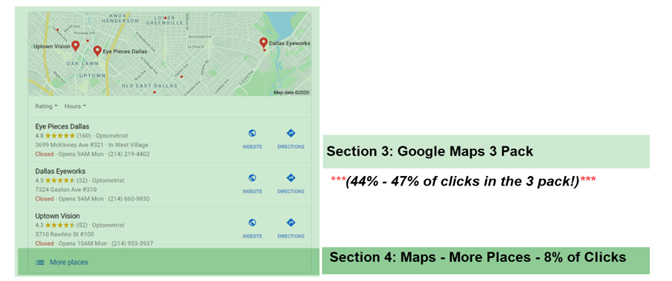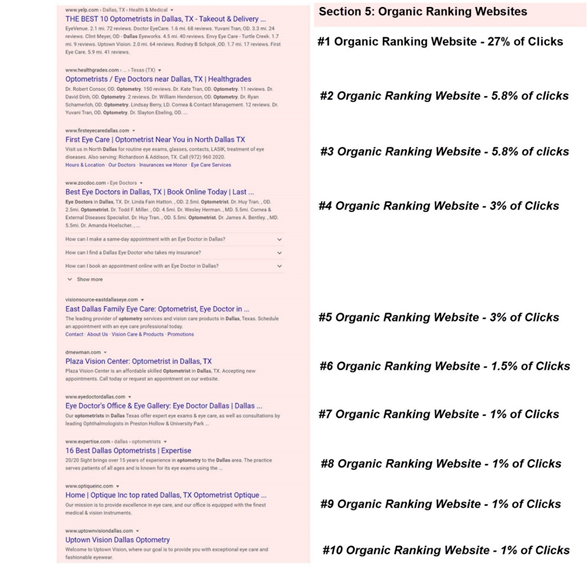By Timothy Edwards, OD
August 5, 2020

In this era of Covid-19 with ever-increasing competition inside optometry, it is important for optometrists to understand the mathematics and statistics of the Google Search Results in order to stay competitive and continually attract new patients. Spending hard-earned money on marketing that does not work or deliver a return on investment, is too often the outcome. As an independent group practice partner-owner for 25 years, who was able to retire at age 52, I now advise other optometrists in how to best market their practices.
Here is the optometry marketing guidance I pass along to all of my clients to ensure that they understand the importance of their practice ranking at the top of the search listings when potential patients are looking for an eye doctor in their city.
What Is Click-Through Rate?
Click-through essentially means how often a person who searches a keyword will click on a Google listing. It is based on where it shows up on page one of the search results. Click HERE to view how the organization of search results looks and works.
Search results on mobile devices appear slightly different than what is shown in the link above, but once a person knows what to look for, they can easily distinguish each section.
What the Anatomy of Specific Search for an OD Looks Like
Here is the anatomy of a Google search result page using the keyword search term– “Optometrist Dallas”:
Keyword Search Box
 Click HERE, or the image above, for an easier-to-read PDF version of the graphic.
Click HERE, or the image above, for an easier-to-read PDF version of the graphic.
Step one of a Google search is the Keyword Search Box. Everyone knows how to use this. Just type in what you are looking for and Google will provide you with what their artificial intelligence algorithm has selected as the most relevant results. Google and other data-collecting vendors keep track of statistics on how many times a month people type this exact keyword. For example, Google knows that on average the search term “Optometrist Dallas” is typed in 720 times per month.
Paid Google Ads
 Click HERE, or the image above, for an easier-to-read PDF version of the graphic.
Click HERE, or the image above, for an easier-to-read PDF version of the graphic.
Near the top of this example page you see the Google Paid Ads Results. This is also known as Pay Per Click and Google Adwords. This is where Google makes a large portion of its billions of dollars each year. The majority of internet searchers DO NOT CLICK on these ads. We have seen statistics that vary from one study to another, but they always show that only 3-13 percent of people will click on these ads. To use the corollary, more than 80 percent of potential patients WILL NOT click in this area. There can be up to four ads here with each position getting its share of clicks.
Google My Business
 Click HERE, or the image above, for an easier-to-read PDF version of the graphic.
Click HERE, or the image above, for an easier-to-read PDF version of the graphic.
This is also known as the Google Maps 3 pack, and among marketers like us, known as the GMB. This is the most important part of the Google Search Results page as this area gets up to 47 percent of the total number of clicks from a keyword search.
Statistics say that only 8 percent of people will click on the area in the bottom of the GMB page that says “More Places.” Obviously, there are huge benefits to having your practice occupy one of the three spots in your area, especially if your practice has more reviews and a higher “star rating” than the other practices appearing here. This is the most important investment where smart optometrists should be spending money for online marketing services.
Other Articles to Explore
Organic Ranking Web Sites
This is where potential patients actually find your web site. As you can tell, you must scroll through MANY other areas of the search results to reach this area. Organic rankings for your web site are important, but they are not as important as they were in past.
There are 10 organic results on each page for each keyword. The breakdown of how many times a web site is actually clicked on is shown on the images as a percentage. The higher your web site is ranked in these organic listings, the more times a potential patient will find your web site and click on it.
Here are statistics to help understand the organic click-through rates on Google. The information shown and the manner in which it is formatted is based upon an industry-first study conducted by BrightLocal.com The percentages displayed may vary slightly based upon which study is referenced, but reflect recently published results compiled from several data-gathering organizations.
Click HERE, or the image above, for an easier-to-read PDF version of the graphic.
The web site occupying position two or position three in the organic rankings will each get approximately 6 percent of all clicks. So, this means that if there are 1,000 searches a month for a keyword, approximately 60 of those searchers will click on the organic listings in position two, and 60 would click on the listing in position three.
The web site occupying position four in the organic rankings will get approximately 3 percent of all clicks. This means that if there are 1,000 searches a month for a keyword, only 30 of those searchers will click on the position four organic listing. I am sure you can do the math for the other listing positions, but here are some of the main points that needs to be made:
a. The number one ranked organic listing gets almost 10 times as many clicks as the web site that is ranked in position 4.
b. The number one ranked organic listing gets as many clicks as ALL THE OTHER web sites on the first page combined.
c. Now there are MORE clicks inside the Google Maps 3 Pack than on any web site. This has shifted the emphasis of how marketing dollars should be spent with ranking in the Maps 3 pack being more important than web site ranking.
Google Paid Ads – Bottom
Click HERE, or the image above, for an easier-to-read PDF version of the graphic.
Paid ads from Google. They have a very LOW click-through rate of under 1 percent. But regardless if anyone would click on one of these ads, Google will still get paid.
Related Searches and Other Pages

Click HERE, or the image above, for an easier-to-read PDF version of the graphic.
Related Searches and Other Pages are grouped together, and are the related searches and other pages after the page one results. We have not found any reliable statistics about what percentage of people will click on the “related searches” area.
However, we do have much data on the percentage of visitors that will click on page two of the search results. If your web site is on the second page or further back on the Google Search Results for any keyword, ONLY 2 percent of people will ever find your web site! Once again, to use the corollary, if your web site is on page two or further back in the search results, then 98 percent of potential patients searching on Google for a new 0ptometrist will not find your web site.
Understanding how Google works and the statistics of click-through rates is important information that every optometrist should know. The landscape of what is working to help build your practice has shifted away from web site rankings and towards Google My Business – Maps 3 Pack rankings. Use this information wisely to evaluate and plan any present or future online marketing campaign.
 Timothy Edwards, OD, is the CEO of Dominant OD, which specializes in providing marketing services for private-practice optometrists. Prior to retirement his single location optometrist only group practice had 49 employees and was collecting $100,000 per week in a town with a population around 120,000. To contact him: tceod@DominantOD.com
Timothy Edwards, OD, is the CEO of Dominant OD, which specializes in providing marketing services for private-practice optometrists. Prior to retirement his single location optometrist only group practice had 49 employees and was collecting $100,000 per week in a town with a population around 120,000. To contact him: tceod@DominantOD.com



























